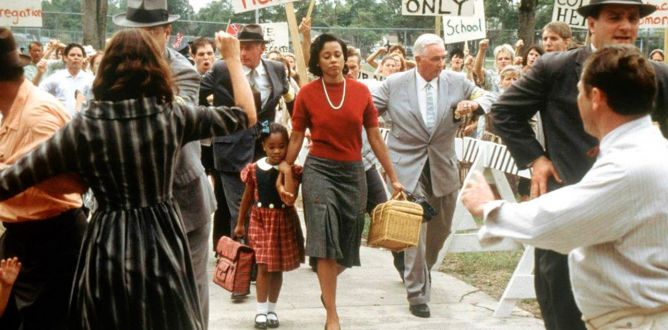Ruby Bridges Parent Guide
Despite its made-for-tv vibe, this film tells a well acted, riveting story that will affect both child and adult audiences.
Parent Movie Review
Most children are apprehensive about transferring to a new school but six-year-old Ruby Bridges’ (Chaz Monet) first day at William Frantz Elementary School is horrifying. Crowds of angry people surround the building, shouting racist epithets and death threats at the little girl, who is flanked by US federal marshals for her own safety. It’s impossible to imagine why adults could direct such hatred at a small child, but this is 1960 and Ruby Bridges is Black. Her tiny body is on the frontlines of the Civil Rights Movement as she becomes one of the first Black children in New Orleans to attend a traditionally white school.
It can be difficult to find civil rights movies that are suitable for kids; fortunately, Ruby Bridges fits the bill. This 1998 Disney made-for-tv film has mediocre production values (not surprising given its provenance) but it tells a true story that can be easily understood by child audiences. The movie’s clear message is that racism is learned behavior and that it can be unlearned. It also clearly demonstrates the ugliness of hate and the terrible damage it wreaks while also shining a light on the power of love, faith and forgiveness.
Ruby Bridges is not a “Christian film” but it is a film in which some of the characters are Christian and their faith is an important part of the story. Lucielle Bridges (Lela Rochon) has a rock solid, radiant faith and imparts it to her daughter. When Ruby questions her about the cruelty of the screaming bigots who threaten her, Lucielle draws on her religious background. Reminding her daughter that Jesus was himself persecuted and rejected, she tells Ruby to pray for those who seek to harm her, just as Jesus did. In one of the most affecting scenes of the film, Ruby recounts how she prays for her persecutors every day. You don’t have to share Ruby’s Christian beliefs to appreciate this film, but fellow believers will be pleased to see their convictions depicted in a positive light.
Director Euzhan Palcy has carefully geared this movie towards a family audience and keeps violence to a minimum. There is enough hate, anger, and peril to make viewers aware of the dangers Ruby and her family face, but there is no on-screen violence. The script is also free from profanity, but there are racial epithets shown on signs and yelled out at Black characters. This is historically accurate but may still upset sensitive viewers.
Overall, Ruby Bridges provides a solid option for parents or teachers trying to introduce elementary school aged children to the Civil Rights Movement. The movie feels a bit clunky at times but the acting is excellent and Chaz Monet is convincing as the self-possessed, indomitable Ruby. Lela Rochon is also believable as Lucielle, a mother determined that her children will have the opportunities she was denied due to the bigotry of the era. The film’s story is deceptively simple but it raises issues that can be understood by kids and should often be assessed by adults. At heart, it’s a story of courage, love, and fighting injustice – and those are the elements of many other great stories. This one just happens to be true.
Directed by Euzhan Palcy. Starring Chaz Monet, Lela Rochon, Michael Beach, Penelope Ann Miller. Running time: 96 minutes. Theatrical release January 18, 1998. Updated March 30, 2023Watch the trailer for Ruby Bridges
Ruby Bridges
Rating & Content Info
Why is Ruby Bridges rated TV-PG? Ruby Bridges is rated TV-PG by the MPAA
Violence: Adults yell threats at a child, including threats to poison her or to choke/hang her until she dies. A child hangs her doll.
Sexual Content: A married couple kiss.
Profanity: Racial slurs are used on several occasions.
Alcohol / Drug Use: Adults are seen drinking beer.
Page last updated March 30, 2023
Ruby Bridges Parents' Guide
Ruby Bridges says that “Racism is learned behaviour. We pass it on to our kids and it continues from one generation to the next.” What have the children in her school learned from their parents about race? How do their opinions change? What does Ruby learn about equality and dignity from her parents? How does her religious faith affect how she faces the challenges she faces at school?
For more information about Ruby Bridges and the broader issue of school desegregation, you can read these articles:
The Guardian: Ruby Bridges: the six-year-old who defied a mob and desegregated her school
Ruby Bridges.com: Meet Ruby
History.com: Little Rock Nine
The Guardian: Little Rock Nine: the day young students shattered racial segregation
Life.com: Brave Hearts: The Little Rock Nine
National Geographic Kids: The road to school desegregation
American RadioWorks: How did school desegregation happen?
Loved this movie? Try these books…
If you want to hear the story in Ruby Bridges’ own words, you will want to read her picture book I Am Ruby Bridges, which is illustrated by Nikkolas Smith. She has also recounted her story for young readers in Ruby Bridges Goes to School: My True Story. Older elementary and middle school readers can learn more from her book Through My Eyes.
Child psychologist Robert Coles has also recounted his experiences with Ruby in The Story of Ruby Bridges: True Story of a Civil Rights Icon. This kids’ book is illustrated by George Ford.
Readers who prefer graphic novels will appreciate Ruby Bridges Takes Her Seat, written by Myra Faye Turner and illustrated by Dante Ginevra.
Ruby Bridges wasn’t the only Black child putting herself at risk for school desegregation. In Warriors Don’t Cry Melba Pattillo Beals shares her experience as one of the Little Rock Nine, a group of Black students who attended the local white high school. This story is also told in Stephanie Fitzgerald’s Little Rock Nine: Struggle for Integration.
In A Girl Stands at the Door, Rachel Devlin focuses on the role of Black women in the desegregation of America’s schools. This is geared at mature teens and adults.
Home Video
Related home video titles:
Bigotry in the workplace comes to the screen in Hidden Figures. This PG-rated film is suitable for older kids and tells the story of the Black women who provided the computational skills that sent men to the moon.
The issue of segregation and racial discrimination is handled at a child’s level in the British movie Railway Children. In this story, kids find an injured American soldier who has been beaten due to his race.

